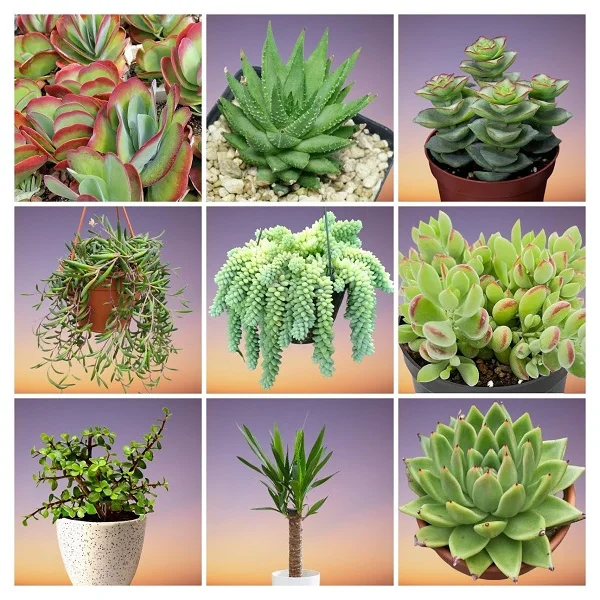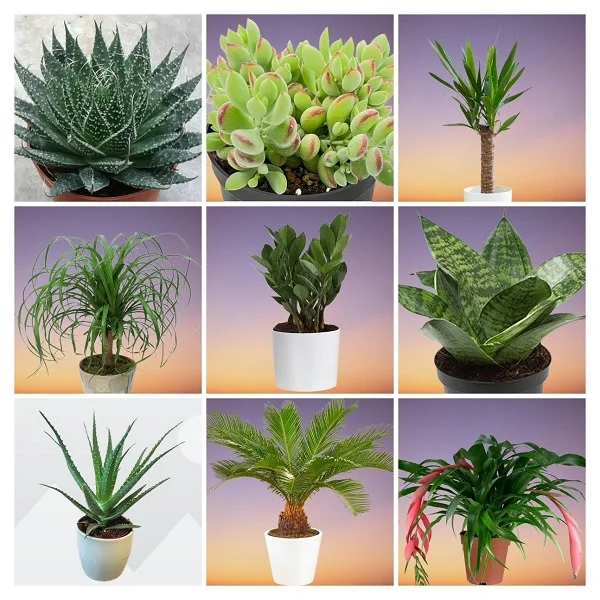Silver Dollar Jade Plant (Crassula arborescens) Indoor Care, Problems & Solutions
Some links in this post may be affiliate links
Silver Dollar Jade Plant (Crassula arborescens) grows best in bright light with some sunlight, average warmth and humidity, and moderately moist, rich, well-drained soil coupled with monthly feeding in spring and summer.
Crassula arborescens also called Silver Dollar Plant is among the popular Crassula varieties and bears rounded blue-gray leaves with maroon edges and small maroon speckles on the upper surface.
The small maroon speckles are technically called 'hydathodes' whose function is to help the plant absorb moisture from the atmosphere. They are especially useful in the plant's naturally dry environment.
Silver Dollar Plant has thick, succulent, smooth, green-gray stems which become woody with age. The stem is highly branched. Due to this characteristic, the plant can easily be trained into a bonsai.
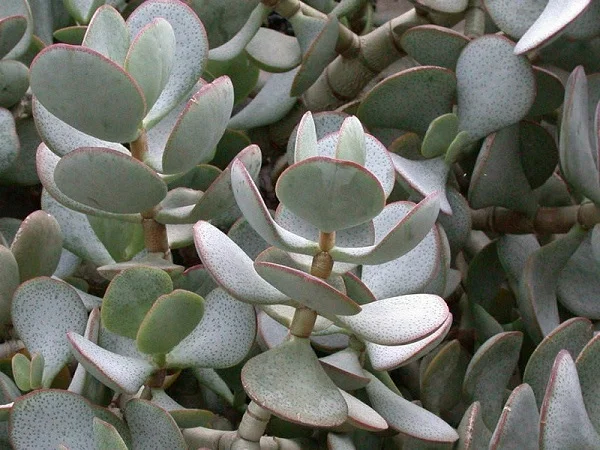
Botanical name: Crassula arborescens
Synonmy: Crassula cotyledonifolia, Cotyledon punctata
Family: Crassulaceae
Common names: Silver Dollar Jade, Silver Dollar Plant, Tree Crassula
Origin
Crassula arborescens also called Crassula cotyledonifolia or Cotyledon punctata is endemic to western Cape in South Africa.
How big does Crassula arborescens get?
Crassula arborescens can grow to a height of 2-4 feet and a spread of about 3-4 feet.
Flowers
Silver Dollar Plant blooms in spring to summer though it is unlikely to flower indoors. The flowers are small, white to pink, star-shaped and form around an upright stem.
Air Cleaning
Silver Dollar Jade is among the CAM (Crassulacean Acid Metabolism) plants which harvest Carbon dioxide at night and use it during the day to make their food.
As they make food (photosynthesize) during the day, CAM plants store the oxygen they produce in the process and release it at night. Therefore, having this plant in your living spaces increases the oxygen concentration which cleans (freshens) the indoor air.
Is Crassula arborescens poisonous?
Yes. Crassula arborescens like its cousin, Jade Plant, is considered toxic to both humans and pets as indicated by ASPCA. If ingested it can cause nausea, vomiting and diarrhea. Keep the plant away from the reach of children, cats, dogs and other pets.
Where to Buy
Silver Dollar Plant are charming plants to add to your collection, check them out on Etsy (Link to Etsy).
How to Care for Silver Dollar Jade Plant indoors?
To care for Silver Dollar Jade Plant indoors, provide bright light with 6-8 hours of direct sunlight, warmth of 15-260C, humidity of 50-55% and moderately moist, rich, well-drained soil coupled with monthly feeding in spring and summer.
Crassula arborescens care does need frequent repotting as it grows best when pot-bound. Pruning is necessary to keep the plant neat, to discourage pest and disease infestations and to control growth. Keep reading for more on these growing conditions and how to provide them.
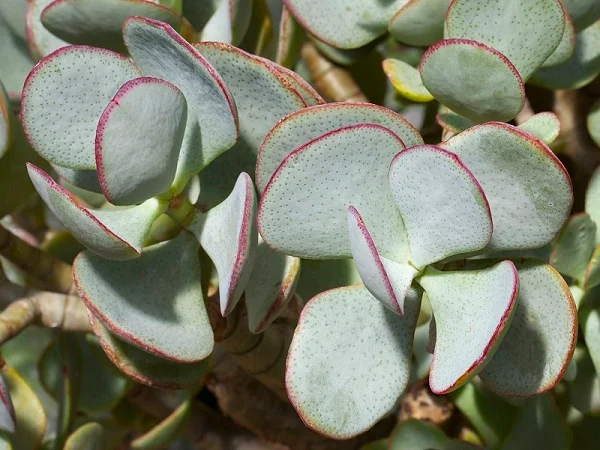
Watering
How often do you water Silver Dollar Plant?
Water your Silver Dollar Plant deeply in spring and summer while allowing the top half of soil to dry out between waterings. Keep the soil moderately moist and avoid overwatering to prevent rotting, yellowing and leaf drop.
Lessen watering in fall and winter as growth is minimal to maintain the soil barely moist but do not let it dry out completely to avoid wilting and leaf drop.
Only use water that is at room temperature to avoid cold shock which can cause reduced growth and sudden leaf loss. Use chlorine-free water to prevent browning of the leaves.
Make sure that the pot has a drainage hole and the soil is free-draining to avoid waterlogging as it can result in rotting and death of the plant.
Take care not to wet the foliage as it can lead to fungal diseases; you may water from the bottom instead.
Light Requirements
How much light does a Silver Dollar Jade Plant need?
Silver Dollar Jade Plant needs very bright light with at 6-8 hours of direct sunshine. Keep it away from too hot midday sunshine to prevent scorching of the leaves.
If the light is not adequate, the plant will become leggy with weak stems, wide spaces between the leaf nodes and small pale leaves. Therefore, where the natural lighting is not sufficient, use a full spectrum grow light to supplement it.
Rotate the pot regularly to ensure that the plant receives light on all sides for a balanced growth and to prevent lopsided growth.
You can choose to grow the your Silver Dollar Plant outdoors, however, gradually acclimate it and place it in a shaded place to avoid scorching the leaves.
Temperature & Humidity
Silver Dollar Jade requires a warmth of 15-260C in spring and summer and a minimum of 100C in fall and winter. Keep it away from sources of drafts like AC units, heat sources, windy windows and doors as they can cause stunted growth, leaf drop and brown leaf spots.
Silver Dollar Plant flourishes in a humidity of 50-55%; it has no need for high humidity. Always make sure that there is good air circulation to prevent fungal disease infestations which are prevalent in damp, poorly ventilated conditions.
Fertilizer
Feed your Silver Dollar Jade with a cactus and succulents fertilizer monthly in spring and summer for lush growth. Take care not to overfeed as the plant is a slow grower.
Stop feeding in fall and winter as growth is minimal at this time and feeding at this time can result in fertilizer burn and death of the plant.
Every 2-3 months, leach out excess salts by running a stream of water through the soil until the water drains through the drainage hole. Let it run for about 5-10 minutes to get rid of most of the salts.
Potting Soil
The best soil for Silver Dollar Plant should be rich in organic matter, loose and free-draining to prevent it from getting soggy. The soil should be loose enough to allow water to drain out fast enough. Most Cactus and succulents potting mixes are ideal for this plant as they do not hold excessive amounts of water.
Repotting
Repot Silver Dollar Jade at the beginning of the growing season (spring to early summer), only when it is crowded in its current pot. Use a pot that is only one size larger than the current one to avoid overpotting.
Confirm that the pot has a drainage hole and the soil is fast-draining to avoid getting soggy which can lead to root-rot. Use a clay pot as it is porous and allows the soil to dry out faster which prevents it from staying wet for too long. Take a look at these terracotta pots with saucer on Amazon.
Pruning & Grooming
Pruning Silver Dollar Plant involves removal of any dead or diseased leaves to keep it neat and also discourage pest and disease infestations. Snip the leaves at the base with a sterilized knife or pair of scissors to prevent diseases transmission.
Cutback the plant at the beginning of the growing season (spring to early summer), to control growth if it is too large. Minimize the number of cuts as much as possible to avoid unnecessary injuiries to reduce disease infestations.
Regularly clean the leaves by damp-wiping with a soft cloth to get rid of dust and discourage pests and diseases infestations. Take care not to damage the fragile leaves.
Silver Dollar Plant Propagation
Silver Dollar Plant (Crassula arborescens) is propagated from stem cuttings, leaf cuttings or offsets at the beginning of the growing season when in active growth. The cuttings can be rooted either in water or in soil.
Learn how to propagate Silver Dollar Plant (Crassula arborescens) in 5 easy ways.
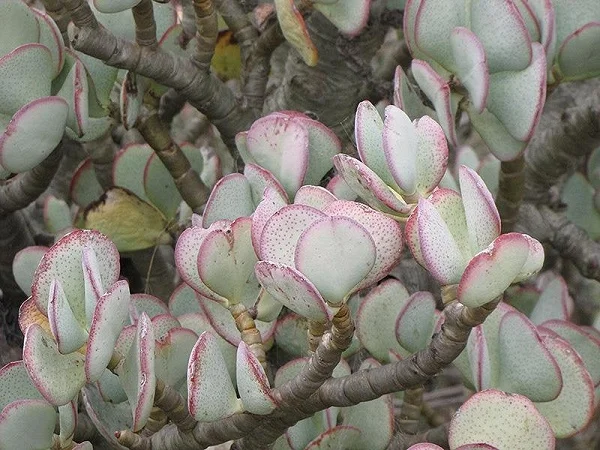
Crassula arborescens Problems & Remedies
Silver Dollar Plant problems are plant dying, yellow leaves, leaf drop, leggy growth, pests and diseases among others. Keep reading for more on these problems and how to solve them.
Plant dying
Why is my Silver Dollar Plant dying?
Your Silver Dollar Plant is dying due to root-rot which is prevalent in soggy soil. The disease is characterized by yellowing and wilting of the leaves which is rapidly followed by browning and plant collapse.
How to fix it
- Gently, slip the plant out of its pot and inspect the roots; brown-black mushy roots indicate root-rot.
- Cut away the rotten roots and treat the healthy roots with a copper-based fungicidal solution as indicated by the manufacturer.
- Repot the plant in fresh soil and a fresh pot. Use a pot with a drainage hole and well-draining soil to prevent it from getting soggy.
- Place the plant in very bright light and stop watering for a few days to give the plant enough time to loss the excess water. After the dry period, resume routine care.
Yellow leaves
The main causes of yellow leaves on your Crassula arborescens are insufficient light, soggy soil, inconsistent watering, drafts, nutrients deficiency or aging.
How to fix it
Insufficient light: Position the plant in bright light with 4-6 hours of direct sunlight or use a grow light if you do not have adequate light in your home.
Soggy soil: Use well-draining soil and a pot that has a drainage hole.
Inconsistent watering: Water when the top 2-3 inches of soil dry out but do not allow the soil to dry out completely.
Drafts: Keep the plant away from sources of drafts like hot air vents, AC units, hot surfaces, windy doors and others.
Nutrients deficiency: Feed the plant monthly in spring and summer with a cactus and succulents fertilizer.
Aging: This is a natural process. As the lower leaves mature, they turn yellow, brown and eventually die.
Leaf drop
Leaf drop on Silver Dollar Plant is caused by use of cold water, inconsistent watering, soggy soil or cold drafts.
How to fix it
Use of cold water: Water the plant with water that is at room temperature to avoid shocking it.
Inconsistent watering: Do not water on a schedule. Water when the top 2-3 inches soil dry out but never allow the soilball to dry out completely.
Soggy soil: Use a pot with a drainage hole and well-draining succulents soil.
Cold drafts: Keep the plant away from cold drafts emanating from AC units, windy doors, drafty windows and others.
Leggy growth
Leggy growth on Silver Dollar Jade is due to overwatering, soggy soil or too little light.
How to fix it
Overwatering: Lessen watering in the cold season to keep the soil barely moist.
Soggy soil: Ensure that the pot has a drainage hole and the soil is well draining.
Too little light: Place the plant in very bright light with 6-8 hours of direct sunlight or instal a grow light if the natural lighting is not adequate.
Pests
Common pests on Silver Dollar Jade Plant are scale insects, mealybugs and spider mites.
How to fix it
- Isolate the affected plant to prevent spread to other plants.
- Treat the infested plant with neem oil or insecticidal soap as per the manufacturers' instructions.
- Check between the leaves for these pests and carry out timely control measures.
- Maintain the plant well pruned to discourage the pest infestations.
Diseases
Silver Dollar Jade is prone to the following three diseases:
1. Powdery mildew which is characterized of spotting or coating of the leaf surface with a white powdery deposit.
How to fix it
- Remove the badly affected leaves and discard or burn to reduce spread to other parts of the plant.
- Spray the plant with a systemic fungicide. Ensure to follow the instructions on the label.
- Water the plant from the bottom to avoid wetting the foliage.
- Improve the air circulation for your plant to reduce the occurrence of the disease.
2. Black leg disease which is prevalent in overwet conditions coupled with poor air circulation. The symptoms manifest as oval, sunken, light-brown to black cankers with purple-to-black margins near the base of the stem.
How to fix it
- Isolate the affected plant to minimize spread to other plants.
- Treat the infected plant with neem oil as instructed by the manufacturer.
- Improve ventilation and make sure that there is free air circulation for the plant.
- Always allow the top half of soil to dry out between waterings.
- Empty excess water from the catch plate and do not allow the plant to sit in soggy soil.
- Make sure that the pot has a drainage hole and that the soil is free-draining.
3. Leaf spot disease which is enhanced by poor air circulation coupled with damp conditions. It presents as brown, soft leaf spots.
How to fix it
- Isolate the affected plant and treat it with systemic fungicide as per the manufacturer's recommendations.
- Avoid wetting the leaves during watering to minimize the disease infestation; water from the bottom instead.
- Better the air flow for the plant to discourage the disease.
You liked it? Share on social media.
Related Content
Amazon Associates Disclosure
Homeplantsguide.com is a participant in the Amazon Services LLC Associates Program, an affiliate advertising program designed to provide a means for sites to earn advertising fees by advertising and linking to amazon.com.



